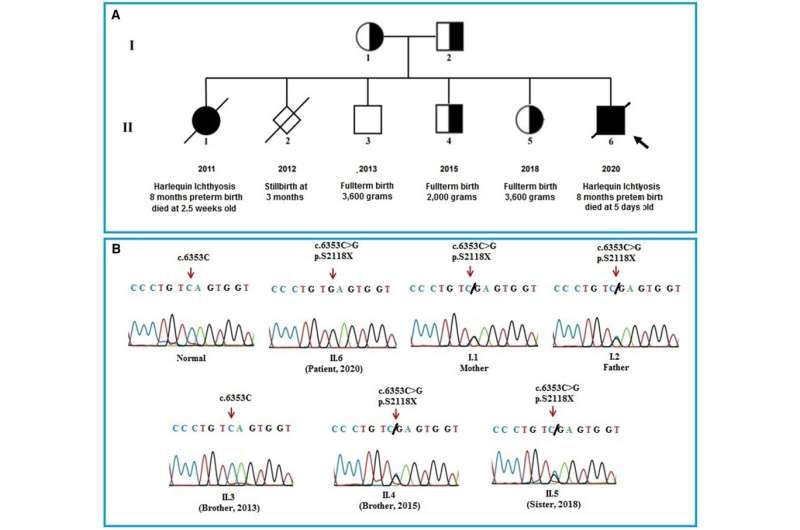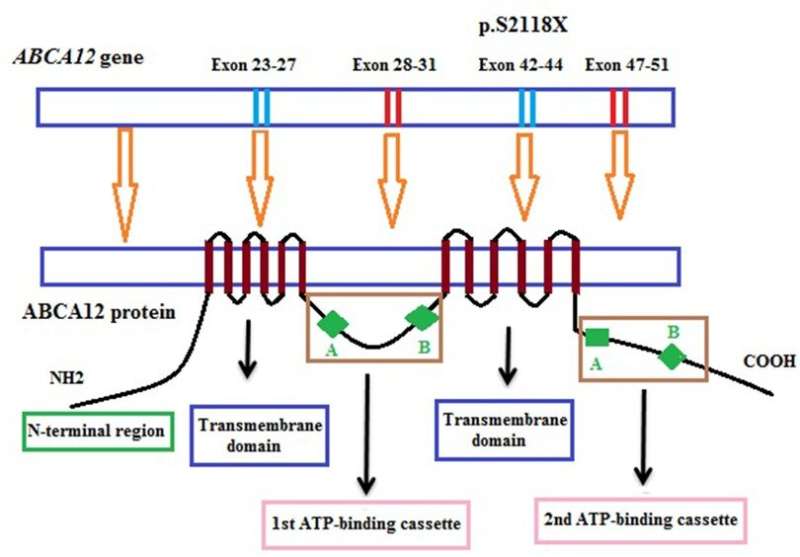This article has been reviewed according to Science X's editorial process and policies. Editors have highlighted the following attributes while ensuring the content's credibility:
fact-checked
proofread
Novel rare skin mutation gene identified by whole exome sequencing

Harlequin ichthyosis (HI) is a severe genetic skin disorder characterized by thick white, brown, or dark brown patches on the skin covering a newborn's entire body. HI has a low incidence of 1 per 300,000 live births but comes with the highest mortality rate among skin conditions. It is caused by a mutation in the ABCA12 gene, which codes for a protein involved in transporting lipids necessary for the formation of the skin barrier. Such protein shortage leads to a weaker epidermal barrier.
A recent study, co-authored by BGI Genomics Dr. Thomas Qiu, published in Frontiers in Pediatrics covers the case of an infant born prematurely at the Vietnam Quang Ninh Obstetrics and Pediatrics Hospital with a birth weight of 2.2 kg and covered with thick plate-like scales separated by dark red fissures of the skin, who was then diagnosed with HI disorder.
Five days after birth, the child was transferred to the Vietnam National Hospital of Pediatrics with severe infection, other HI-related symptoms, breathing difficulties and died 15 hours after.
The infant had an older sister, born 8 months premature who died at 2.5 weeks old with HI symptoms as well, and a stillborn brother at 12 weeks gestation. He also has two brothers and a sister, full health. A blood sample for whole exome sequencing (WES) was collected on the patient to find the cause of the disease.
Whole exome sequencing results show that a homozygous mutation (c.6353C > G, p.S2118X) leads to a truncated ABCA12 protein, commonly reported among HI cases. The formed protein is severely dysfunctional and this is responsible for the serious phenotype in the patient.

The mutation c.6353C > G (p.S2118X) has not been reported yet in previous studies and in the databases (1,000 Genome, gnomAD, NCBI, HGMD, UCSC, ExAc, and NHLBI). This mutation has been submitted in dsSNP under accession number rs1553520447 and Gene Dx under accession number SCV000710591.2, as well as identified as a pathogenic variant in the ClinVar database (accession number RCV000598766.1).
WES also reveals that members of the family who carry the mutation in the heterozygous state do not show HI symptoms, thus emphasizing the importance of genetic screening and DNA-based prenatal diagnosis for families with a history of this disease. While the mortality rate remains high, early intervention with systemic retinoids can improve survival rates. Further research into the pathogenesis of HI and the development of new therapies is crucial to improve the outlook for those affected by this condition.
More information: Van Khanh Tran et al, Case Report: Novel rare mutation c.6353C > G in the ABCA12 gene causing harlequin ichthyosis identified by whole exome sequencing, Frontiers in Pediatrics (2023). DOI: 10.3389/fped.2023.1128716




















